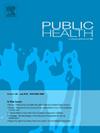改进闲暇时间身体活动不平等的制图:利用人工智能对巴西小区域进行预估
IF 3.2
3区 医学
Q1 PUBLIC, ENVIRONMENTAL & OCCUPATIONAL HEALTH
引用次数: 0
摘要
目的:我们估算了贝洛奥里藏特市小区域的休闲时间体育活动(LTPA)的流行程度,并分析了2009-2013年和2014-2018年两个时间段内不同地区的不平等现象。研究设计利用聚类数据进行小面积估计。方法采用巴西贝洛奥里藏特市2009 - 2018年慢性病风险和保护因素监测(Vigitel)数据。首先,在该市人口普查区(3830个)进行地理参考(n = 16019)访谈。其次,健康脆弱性指数(IVH)的社会经济和卫生成分(用于对人口普查区进行分类的指标)作为k-均值聚类技术的输入变量,将相对于IVS成分具有较高同质性的较小区域的人口普查区分组。最后,通过对样本施加分层后权重,直接估计每个集群的LTPA患病率。计算不同时期之间的绝对和相对差异以及不同集群之间的患病率差异,以分析不平等。结果共发现9个聚类。2009-2013年期间,LTPA的患病率在高危区23.70%至低危区45.55%之间,2014 - 2018年期间,LTPA的患病率在高危区31.44%至低危区52.81%之间。在处境较不利的群体中,不平等现象有所减少,但最低和最高脆弱群体之间的不平等现象仍然很大。结论小面积估算有利于提高卫生监测的准确性。鼓励不同的机器学习方法为地方层面的更有针对性的干预提供信息。本文章由计算机程序翻译,如有差异,请以英文原文为准。
Improving the mapping of leisure-time physical activity inequities: the use of artificial intelligence to advance estimates of small-areas in Brazil
Objective
We estimated the prevalence of leisure-time physical activity (LTPA) in small areas of the city of Belo Horizonte and analyzed inequities across areas and between two time periods, 2009–2013 and 2014–2018.
Study design
Small area estimation using clustered data.
Methods
Data from the Surveillance of Risk and Protective Factors for Chronic Diseases (Vigitel) between 2009 and 2018 for the city of Belo Horizonte, Brazil, were used. Firstly, interviews were georeferenced (n = 16,019) in the census tracts (3,830) of the city. Secondly, the socioeconomic and sanitation components of a Health Vulnerability Index (IVH), indicator used to classify census tracts, served as input variables for a k-means clustering technique to group the tracts in smaller areas of higher homogeneity in relation to IVS components. Lastly, direct estimation of LTPA prevalence was obtained in each cluster by applying post-stratification weights to sample. Absolute and relative differences were calculated between periods and prevalence differences between clusters to analyze inequalities.
Results
Nine clusters were found. LTPA prevalence ranged from 23.70 % in a very high-risk cluster to 45.55 % in a low-risk cluster during the 2009–2013 period, and from 31.44 % in a high-risk cluster to 52.81 % in a low-risk cluster from 2014 to 2018. Reducing inequities were observed among the more disadvantaged clusters, but it remained persistently large between the lowest and highest vulnerability groups.
Conclusion
Small area estimates are an advantage for a more accurate level of health surveillance. Different machine learning methods are encouraged to provide information for more tailored interventions at local level.
求助全文
通过发布文献求助,成功后即可免费获取论文全文。
去求助
来源期刊

Public Health
医学-公共卫生、环境卫生与职业卫生
CiteScore
7.60
自引率
0.00%
发文量
280
审稿时长
37 days
期刊介绍:
Public Health is an international, multidisciplinary peer-reviewed journal. It publishes original papers, reviews and short reports on all aspects of the science, philosophy, and practice of public health.
 求助内容:
求助内容: 应助结果提醒方式:
应助结果提醒方式:


